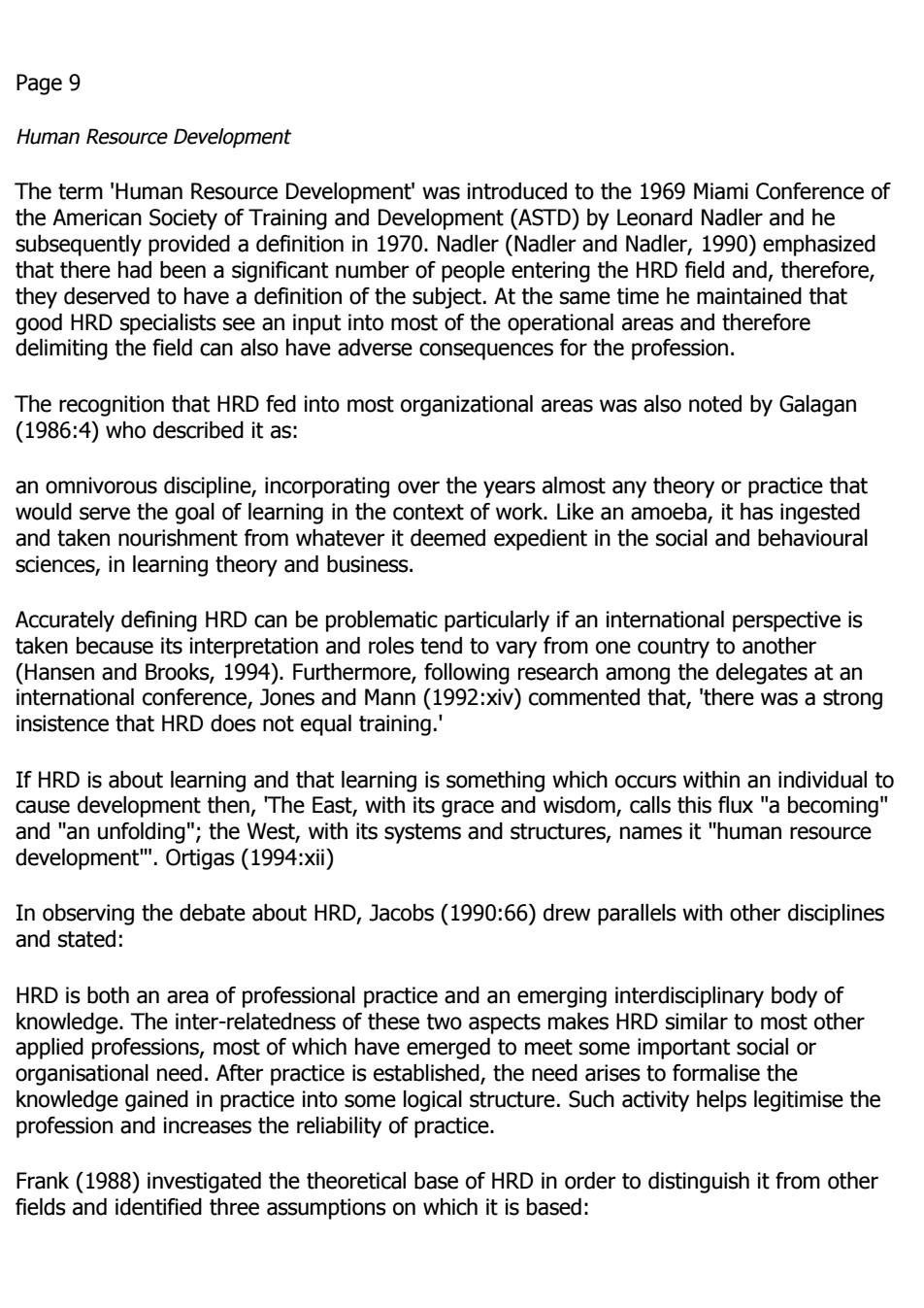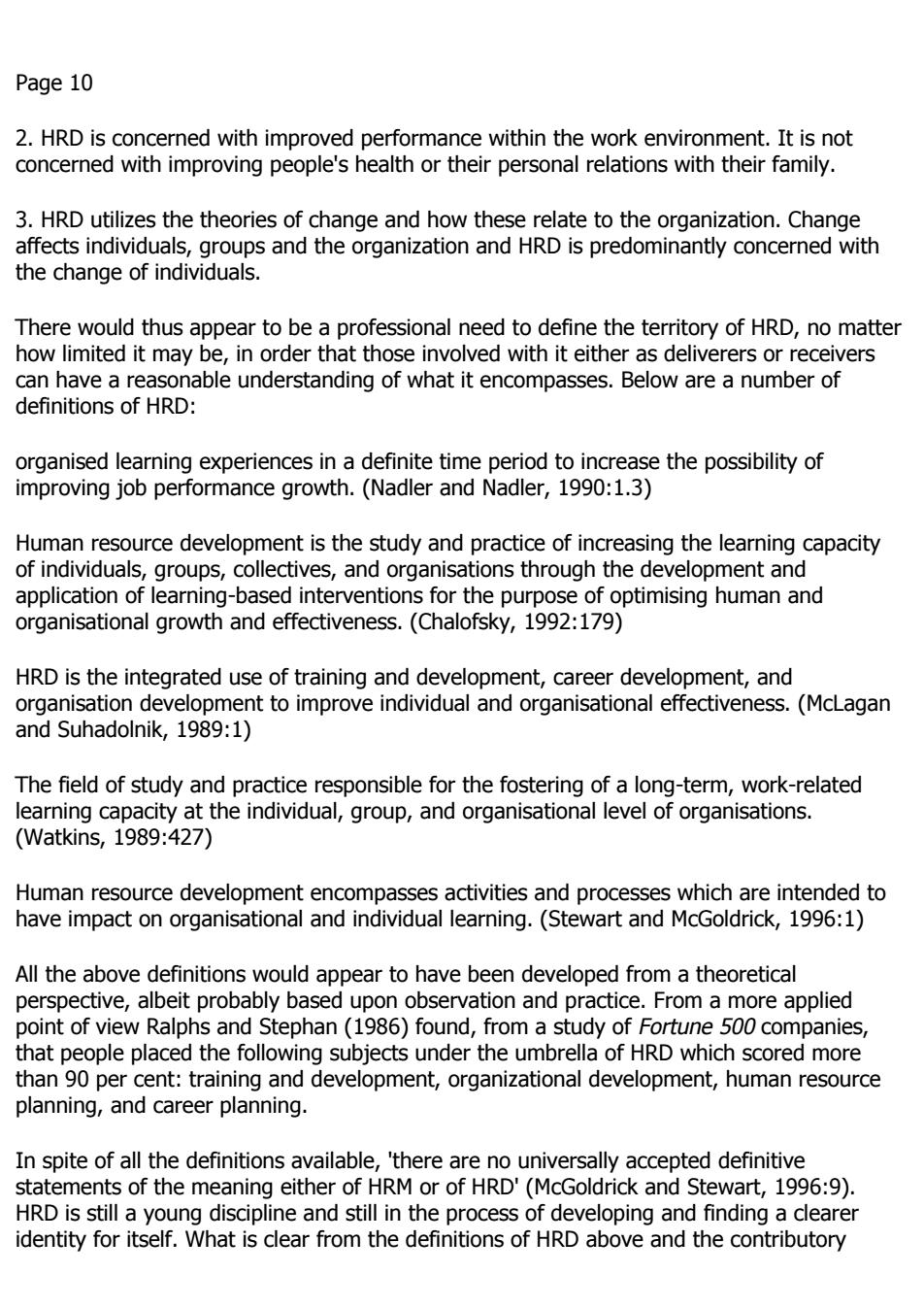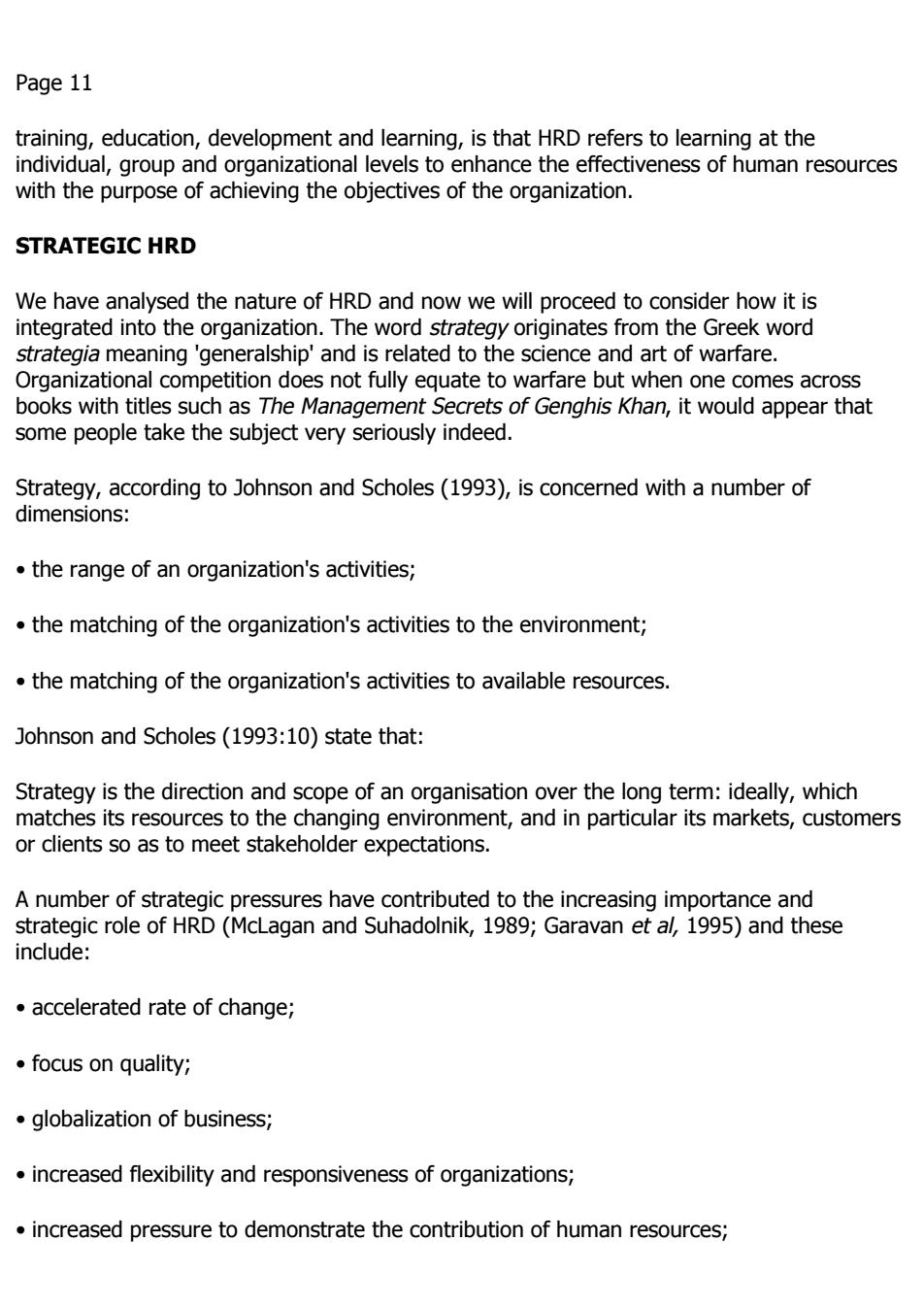
Page 9 Human Resource development The term'Human resource development was introduced to the 1969 miami conference of the American Society of Training and Development(ASTD)by Leonard Nadler and he subsequently provided a definition in 1970.Nadler(Nadler and Nadler,1990)emphasized that there had been a significant number of people entering the HRD field and,therefore, they deserved to have a definition of the subject.At the same time he maintained that good HRD specialists see an input into most of the operational areas and therefore delimiting the field can also have adverse consequences for the profession. The recognition that HRD fed into most organizational areas was also noted by Galagan (1986:4)who described it as: an omnivorous discipline,incorporating over the years almost any theory or practice that would serve the goal of learning in the context of work.Like an amoeba,it has ingested and taken nourishment from whatever it deemed expedient in the social and behavioura sciences,in learnina theory and business. Accurately defining HRD can be problematic particularly if an international perspective is taken because its interpretation and roles tend to vary from one country to another (Hansen and Brooks,1994).Furthermore,following research amo ng the delegates at an international conference,Jones and Mann(1992:xiv)commented that,'there was a strong insistence that HRD does not equal training. If HRD is about learning and that learning is something which occurs within an individual to cause development then, The East,with its grace and wisdom,calls this flux"a becoming and "an unfolding";the West,with its systems and structures,names it "human resource development".Ortigas(1994:xii) In observing the debate about HRD,Jacobs(1990:66)drew parallels with other disciplines and stated: HRD is both an area of professional practice and an emerging interdisciplinary body of knowledge.The inter-relatedness of these two aspects makes HRD similar to most other applied professions,most of which have emerged to meet some important social or organisational need.After practice is established,the need arises to formalise the knowledge gained in practice into some logical structure.Such activity helps legitimise the profession and increases the reliability of practice. Frank(1988)investigated the theoretical base of HRD in order to distinguish it from other fields and identified three assumptions on which it is based:
Page 9 Human Resource Development The term 'Human Resource Development' was introduced to the 1969 Miami Conference of the American Society of Training and Development (ASTD) by Leonard Nadler and he subsequently provided a definition in 1970. Nadler (Nadler and Nadler, 1990) emphasized that there had been a significant number of people entering the HRD field and, therefore, they deserved to have a definition of the subject. At the same time he maintained that good HRD specialists see an input into most of the operational areas and therefore delimiting the field can also have adverse consequences for the profession. The recognition that HRD fed into most organizational areas was also noted by Galagan (1986:4) who described it as: an omnivorous discipline, incorporating over the years almost any theory or practice that would serve the goal of learning in the context of work. Like an amoeba, it has ingested and taken nourishment from whatever it deemed expedient in the social and behavioural sciences, in learning theory and business. Accurately defining HRD can be problematic particularly if an international perspective is taken because its interpretation and roles tend to vary from one country to another (Hansen and Brooks, 1994). Furthermore, following research among the delegates at an international conference, Jones and Mann (1992:xiv) commented that, 'there was a strong insistence that HRD does not equal training.' If HRD is about learning and that learning is something which occurs within an individual to cause development then, 'The East, with its grace and wisdom, calls this flux "a becoming" and "an unfolding"; the West, with its systems and structures, names it "human resource development"'. Ortigas (1994:xii) In observing the debate about HRD, Jacobs (1990:66) drew parallels with other disciplines and stated: HRD is both an area of professional practice and an emerging interdisciplinary body of knowledge. The inter-relatedness of these two aspects makes HRD similar to most other applied professions, most of which have emerged to meet some important social or organisational need. After practice is established, the need arises to formalise the knowledge gained in practice into some logical structure. Such activity helps legitimise the profession and increases the reliability of practice. Frank (1988) investigated the theoretical base of HRD in order to distinguish it from other fields and identified three assumptions on which it is based:

1.HRD is based on the research and theories drawn from the field of adult education and is different from the learning that occurs in children.Learning is based on creating the appropriate circumstances in which adults can learn and thereby change behaviour
1. HRD is based on the research and theories drawn from the field of adult education and is different from the learning that occurs in children. Learning is based on creating the appropriate circumstances in which adults can learn and thereby change behaviour

Page 10 2.HRD is concerned with improved performance within the work environment.It is not concerned with improving people's health or their personal relations with their family. 3.HRD utilizes the theories of change and how these relate to the organization.Change affects individuals,groups and the organization and HRD is predominantly concerned with the change of individuals There would thus appear to be a professional need to define the territory of HRD,no matter how limited it may be,in order that those involved with it either as deliverers or receivers can have a reasonable understanding of what it encompasses.Below are a number of definitions of HRD: organised learning experiences in a definite time period to increase the possibility of improving job performance growth.(Nadler and Nadler,1990:1.3) Human resource development is the study and practice of increasing the learning capacity of individuals,groups,collectives,and organisations through the development and application of learning-based interventions for the purpose of optimising human and organisational growth and effectiveness.(Chalofsky,1992:179) HRD is the integrated use of training and development,career development,and The field of study and practice responsible for the fostering of a long-term,work-related learning capacity at the individual,group,and organisational level of organisations. (Watkins,1989:427) Human resource development encompasses activities and processes which are intended to have impact on organisational and individual learning.(Stewart and McGoldrick,1996:1) All the above definitions would appear to have been developed from a theoretical perspective,albeit probably based upon observation and practice.From a more applied point of view Ralphs and Stephan(1986)found,from a study of Fortune 500 companies. that people placed the following subjects under the umbrella of HRD which scored more than 90 per cent:training and development,organizational development,human resource planning,and career planning In spite of all the definitions available,'there are no universally accepted definitive statements of the meaning either of HRM or of HRD'(McGoldrick and Stewart,1996:9). HRD is still a young discipline and still in the process of developing and finding a clearer identity for itself.What is clear from the definitions of HRD above and the contributory
Page 10 2. HRD is concerned with improved performance within the work environment. It is not concerned with improving people's health or their personal relations with their family. 3. HRD utilizes the theories of change and how these relate to the organization. Change affects individuals, groups and the organization and HRD is predominantly concerned with the change of individuals. There would thus appear to be a professional need to define the territory of HRD, no matter how limited it may be, in order that those involved with it either as deliverers or receivers can have a reasonable understanding of what it encompasses. Below are a number of definitions of HRD: organised learning experiences in a definite time period to increase the possibility of improving job performance growth. (Nadler and Nadler, 1990:1.3) Human resource development is the study and practice of increasing the learning capacity of individuals, groups, collectives, and organisations through the development and application of learning-based interventions for the purpose of optimising human and organisational growth and effectiveness. (Chalofsky, 1992:179) HRD is the integrated use of training and development, career development, and organisation development to improve individual and organisational effectiveness. (McLagan and Suhadolnik, 1989:1) The field of study and practice responsible for the fostering of a long-term, work-related learning capacity at the individual, group, and organisational level of organisations. (Watkins, 1989:427) Human resource development encompasses activities and processes which are intended to have impact on organisational and individual learning. (Stewart and McGoldrick, 1996:1) All the above definitions would appear to have been developed from a theoretical perspective, albeit probably based upon observation and practice. From a more applied point of view Ralphs and Stephan (1986) found, from a study of Fortune 500 companies, that people placed the following subjects under the umbrella of HRD which scored more than 90 per cent: training and development, organizational development, human resource planning, and career planning. In spite of all the definitions available, 'there are no universally accepted definitive statements of the meaning either of HRM or of HRD' (McGoldrick and Stewart, 1996:9). HRD is still a young discipline and still in the process of developing and finding a clearer identity for itself. What is clear from the definitions of HRD above and the contributory

areas of
areas of

Page 11 training,education,development and learning,is that HRD refers to learning at the individual,group and organizational levels to enhance the effectiveness of human resources with the purpose of achieving the objectives of the organization. STRATEGIC HRD We have analysed the nature of HRD and now we will proceed to consider how it is integrated into the organization.The word strategy originates from the Greek word strategia meaning 'generalship'and is related to the science and art of warfare. Organizational competition does not fully equate to warfare but when one comes across books with titles such as The Management Secrets of Genghis Khan,it would appear that some people take the subject very seriously indeed. Strategy,according to Johnson and Scholes(1993),is concerned with a number of dimensions: the range of an organization's activities; the matching of the organization's activities to the environment; the matching of the organization's activities to available resources. Johnson and Scholes(1993:10)state that: Strategy is the direction and scope of an organisation over the ong term:ideally,which matches its resources to the changing environment,and in particular its markets,customers or clients so as to meet stakeholder expectations. A number of strategic pressures have contributed to the increasing importance and strategic role of HRD(McLagan and Suhadolnik,1989;Garavan et al,1995)and these indlude accelerated rate of change; ●focus on quality; globalization of business; increased flexibility and responsiveness of organizations; increased pressure to demonstrate the contribution of human resources;
Page 11 training, education, development and learning, is that HRD refers to learning at the individual, group and organizational levels to enhance the effectiveness of human resources with the purpose of achieving the objectives of the organization. STRATEGIC HRD We have analysed the nature of HRD and now we will proceed to consider how it is integrated into the organization. The word strategy originates from the Greek word strategia meaning 'generalship' and is related to the science and art of warfare. Organizational competition does not fully equate to warfare but when one comes across books with titles such as The Management Secrets of Genghis Khan, it would appear that some people take the subject very seriously indeed. Strategy, according to Johnson and Scholes (1993), is concerned with a number of dimensions: • the range of an organization's activities; • the matching of the organization's activities to the environment; • the matching of the organization's activities to available resources. Johnson and Scholes (1993:10) state that: Strategy is the direction and scope of an organisation over the long term: ideally, which matches its resources to the changing environment, and in particular its markets, customers or clients so as to meet stakeholder expectations. A number of strategic pressures have contributed to the increasing importance and strategic role of HRD (McLagan and Suhadolnik, 1989; Garavan et al, 1995) and these include: • accelerated rate of change; • focus on quality; • globalization of business; • increased flexibility and responsiveness of organizations; • increased pressure to demonstrate the contribution of human resources;